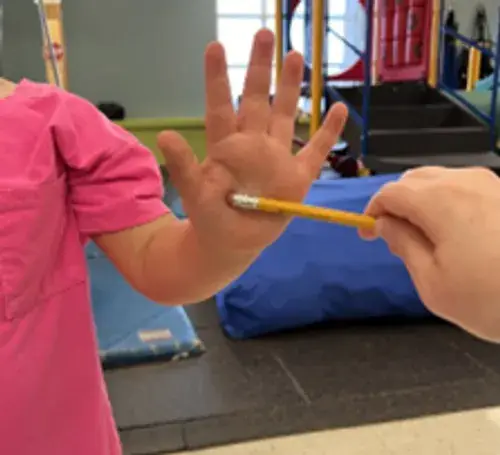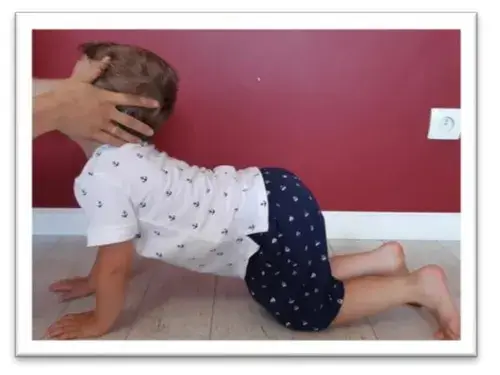In-Clinic Assessment of 8 Core Primitive Reflexes and Brain Speed
on Interactive Metronome IM

Primitive reflexes are a set of automatic, involuntary movements that emerge during gestation or infancy. They are essential for a baby's survival, development of muscle tone, and stimulation of sensory pathways. They are controlled by the brainstem (the lower, less mature part of the brain).
Why Children Don't "Just Grow Out" of Them
The normal process of neurodevelopment requires these reflexes to become integrated (or inhibited) by the higher brain centers, typically within the first few months to a year of life. This integration paves the way for postural reflexes—voluntary, mature, and adaptive motor patterns that allow for upright movement, coordination, and focus.
When a primitive reflex is retained (unintegrated), it doesn't just disappear; it remains active and automatically interrupts the child's development. It acts as a neurological "roadblock" that forces the lower brain to stay dominant. The child is then constantly expending energy trying to override this automatic response, diverting resources away from higher-level skills necessary for learning, emotional regulation, and complex motor control. They cannot simply "outgrow" this neurological wiring issue; it requires specific, targeted movement and stimulation to complete the integration process.
Link to Mental Health in Adulthood
While retained primitive reflexes are not typically classified as the direct cause of specific mental illnesses, the chronic stress and systemic inefficiencies they create can lay the foundation for or exacerbate adult mental health issues:
-
Moro Reflex & Anxiety: The Moro Reflex is a vestige of the body's "fight-or-flight" survival mechanism. If retained, the individual lives in a state of hyper-arousal, constantly misinterpreting low-level stimuli as a threat. This leads to chronic anxiety, panic attacks, and an exaggerated stress response that can underpin generalized anxiety disorder.
-
Emotional Regulation: Retained reflexes like the Moro and Spinal Galant interfere with the development of higher-level emotional centers. Adults may struggle with emotional regulation, leading to volatility, explosive anger, or extreme shyness and social withdrawal, often mimicking symptoms of mood or personality disorders.
-
Chronic Fatigue & Focus: The constant, subconscious effort required to suppress an active reflex leads to persistent neurological drain and chronic fatigue. Furthermore, the inability to filter sensory input (Moro) and poor cross-lateral connections (ATNR) result in lifelong attention and focus deficits, often associated with ADHD-like symptoms.
In essence, the unintegrated reflex creates a nervous system that is constantly on high alert, poorly coordinated, and inefficient at processing sensory information, significantly increasing the likelihood of developing or struggling with chronic mental and emotional health challenges in adulthood.


Everyday Manifestations of Retained Primitive Reflexes in Children
When primitive reflexes remain active past their due date of integration, they create neurological roadblocks that interfere with a child's learning, motor development, and emotional regulation. This manifests as predictable and persistent struggles across daily life at home, school, and within the community.
Manifestations in Children (Home, School, & Community):
Retained Moro Reflex
Emotional/Sensory: Easily triggered anger or emotional outbursts, shyness, and hypersensitivity to light, movement, sound, touch, and smell. May have cycles of hyperactivity and extreme fatigue. Academic/Motor: Easily distracted (difficulty filtering out noise), poor balance, and difficulty catching a ball.
Asymmetrical Tonic Neck Reflex (ATNR)
Academic: Learning problems with spelling, math, and language, letter and number reversals, poor handwriting, and difficulty with reading due to poor visual tracking.
Motor: Inability to use cross-pattern movements (skipping), and difficulty learning to ride a bike.
Symmetrical Tonic Neck Reflex (STNR)
Motor/Postural: Poor posture at a desk, "W" sitting, and a tendency to anchor feet behind a chair. Vision/Focus: Difficulty focusing from near to far.
Tonic Labyrinthine Reflex (TLR)
Motor/Balance: Poor coordination, poor balance, and motion sickness.
Stamina/Posture: Poor posture and tires easily when standing.
Cognitive: Poor sense of time, rhythm, and poor sequencing skills.
Spinal Galant
Behavioral/Body Awareness: Fidgeting, poor concentration, and dislike of tight clothing or tags.
Physical: Poor bladder control/bedwetting and irritable bowel syndrome.
Rooting & Suck Reflexes
Oral: Messy eaters (difficulty swallowing/chewing, drooling, choking often).
Speech/Motor: Speech and articulation problems, stuttering, and involuntary tongue or mouth movements when writing.
Palmar Reflex
Fine Motor: Poor manual dexterity.
Writing: Tight grip on a pencil and involuntary mouth movements with handwriting.
Everyday Manifestations of Retained Primitive Reflexes in Adults
While primitive reflexes are typically associated with childhood development, their continued presence (unintegrated) in adults contributes to chronic symptoms and persistent challenges across work, home, and social environments. These reflexes force the adult nervous system to operate inefficiently, often leading to anxiety, poor posture, and concentration issues.
Chronic Adult Challenges (Symptoms)
Retained Moro Reflex
Emotional/Anxiety: Chronic anxiety or panic attacks, constant feeling of being "on edge" or easily overwhelmed.
Sensory: Hypersensitivity to light, movement, sound, touch, and smell, causing distress in crowded or loud environments.
Physical: Chronic fatigue and a weak immune system (prone to illness, allergies)
.Asymmetrical Tonic Neck Reflex (ATNR)
Functional/Motor: Difficulty with tasks requiring coordinating two sides of the body (e.g., driving, typing, specific sports). Balance affected by head movement, poor eye-hand coordination, and effortful, poor handwriting.
Symmetrical Tonic Neck Reflex (STNR)
Posture/Work: Chronic poor posture at a desk (slouching or propping the head).
Focus: Difficulty shifting visual focus efficiently, which impacts reading speed and attention.
Tonic Labyrinthine Reflex (TLR)
Motor/Balance: Chronic motion sickness, poor balance, poor coordination, and sometimes a fear of heights.
Posture/Work: Poor posture, difficulty with organization and sequencing tasks, and problems with spatial awareness.
Spinal Galant
Body Awareness/Sensory: Persistent need to fidget or shift position while sitting (constant discomfort). Dislike of tight clothing, tags, or waistbands. May be linked to irritable bowel syndrome.
Rooting & Suck Reflexes
Oral Fixation: Reliance on chewing gum, smoking, biting lips, or sucking candy.
Speech: Persistent articulation difficulties.
Palmar Reflex
Fine Motor: Poor manual dexterity (e.g., struggling to manipulate small objects).
Writing: A tight, effortful, and messy grip when writing or drawing.

